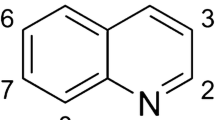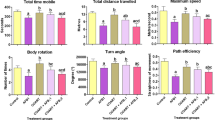Abstract
Artemisinins are fast-acting and highly efficacious antimalarials. There has been a rapid increase in their use in response to increasing drug resistance and further increases in their use are anticipated as they continue to replace existing therapies. In laboratory studies, artemisinins can produce relatively specific brainstem neurotoxicity. Select nuclei in the medulla, pons and mesencephalon are usually found to be most vulnerable. Species-specific differences in the vulnerability of nuclei may also exist. While not yet completely understood, occurrence of the lesion seems to be dependent upon a sustained, rather than peak, level of circulating drug or metabolite. With daily administrations, the onset of signs of brainstem neurotoxicity frequently develops abruptly and sometimes is observable only at the end of, or after, a regimen of administration. Behavioral correlates of brainstem neurotoxicity in laboratory animals include ataxic symptoms such as tremor, gait impairment and balance disturbance. Symptoms may also include auditory impairment. Screening and diagnostic procedures to guard against artemisinin-induced brainstem neurotoxicity in humans need to be based on the available, albeit limited, data from laboratory studies. Substantial and fundamental gaps in our understanding of artemisinin brainstem neurotoxicity exist including the mode of action of neurotoxicity and the specific conditions under which it occurs. Further, the possibility of increased vulnerability from age-related factors, drug interactions and cumulative administration regimens has not yet been investigated. Substantial progress addressing these issues is needed to maintain appropriate pharmacovigilance as the use of these powerful and life-saving antimalarials increases.
Similar content being viewed by others
References
Boivin MJ et al (2007) Cognitive impairment after cerebral malaria in children: a prospective study. Pediatrics 119:360–366
Breman JG et al (2004) Conquering the intolerable burden of malaria: what’s new, what’s needed: a summary. Am J Trop Med Hyg 71:1–15
Brewer TG et al (1998) Factors relating to neurotoxicity of artemisinin antimalarial drugs “listening to arteether”. Med Trop 58:22–27
Brewer TG et al (1994a) Fatal neurotoxicity of arteether and artemether. Am J Trop Med Hyg 51:251–259
Brewer TG et al (1994b) Neurotoxicity in animals due to arteether and artemether. Trans R Soc Trop Med Hyg 88:33–36
Clark RL et al (2004) Developmental toxicity of artesunate and an artesunate combination in the rat and rabbit. Birth Defects Res B Dev Reprod Toxicol 71:380–394
Classen W et al (1999) Differential effects of orally versus parenterally administered qinghaosu derivative artemether in dogs. Exp Toxicol Pathol 51:507–516
Furst M et al (1995) Brainstem lesions and click lateralization in patients with multiple sclerosis. Hear Res 82:109–124
Genovese RF et al (1999) Acute high dose arteether toxicity in rats. Neurotoxicology 20:851–859
Genovese RF et al (1995) Arteether neurotoxicity in the absence of deficits in behavioural performance in rats. Ann Trop Med Parasitol 89:447–449
Genovese RF et al (1998a) Behavioral and neural toxicity of arteether in rats. Pharmacol Biochem Behav 60:449–458
Genovese RF et al (2000) Behavioral and neural toxicity of the artemisinin antimalarial, arteether, but not artesunate and artelinate, in rats. Pharmacol Biochem Behav 67:37–44
Genovese RF et al (1998b) Dose-dependent brainstem neuropathology following repeated arteether administration in rats. Brain Res Bull 45:199–202
Genovese RF et al (2001) Effects of arteether on an auditory radial-arm maze task in rats. Physiol Behav 73:87–91
Golenser J et al (2006) Current perspectives on the mechanism of action of artemisinins. Int J Parasitol 36:1427–1441
Gordi T, Lepist EI (2004) Artemisinin derivatives: toxic for laboratory animals, safe for humans? Toxicol Lett 147:99–107
Hutagalung R et al (2006) A case-control auditory evaluation of patients treated with artemether-lumefantrine. Am J Trop Med Hyg 74:211–214
Jefford CW (2007) New developments in synthetic peroxidic drugs as artemisinin mimics. Drug Discov Today 12:487–495
Kamchonwongpaisan S et al (1997) Artemisinin neurotoxicity: neuropathology in rats and mechanistic studies in vitro. Am J Trop Med Hyg 56:7–12
Karbwang J et al (1998) Pharmacokinetics of artesunate in Thai patients with uncomplicated falciparum malaria. Clin Drug Invest 1:37–43
Koopmans R et al (1999) The pharmacokinetics of artemisinin after administration of two different suppositories to healthy Vietnamese subjects. Am J Med Hyg 60:244–247
Lalloo DG et al (2007) UK malaria treatment guidelines. J Infect 54:111–121
Li QG et al (2002) Neurotoxicity and efficacy of arteether related to its exposure times and exposure levels in rodents. Am J Trop Med Hyg 66:516–525
Li QG et al (1998a) Pharmacology and toxicology of artelinic acid: preclinical investigators on pharmacokinetics, metabolism, protein and red blood cell binding, and acute and anorectic toxicities. Trans R Soc Trop Med Hyg 92:332–340
Li QG et al (1998b) The pharmacokinetics and bioavailability of dihydroartemisinin, arteether, artemether, artesunic acid and artelinic acid in rats. J Pharm Pharmacol 50:173–182
Li QG et al (2006) Fatal neurotoxicity of the artemisinin derivatives are related to drug pharmacokinetic exposure time in animal species. Curr Topics Toxicol 3:1–16
Miller LG, Panossian CB (1997) Ataxia and slurred speech after artesunate treatment for falciparum malaria. N Engl J Med 337:792–793
Modianos DT, Pfaff DW (1976) Brainstem and cerebellar lesions in female rats. I. Tests of posture and movement. Br Res 106:31–46
Nontprasert A et al (2002a) Assessment of the neurotoxicity of oral dihydroartemisinin in mice. Trans R Soc Trop Med Hyg 96:99–101
Nontprasert A et al (1998) Assessment of the neurotoxicity of parenteral artemisinin derivatives in mice. Am J Trop Med Hyg 59:519–522
Nontprasert A et al (2002b) Neuropathologic toxicity of artemisinin derivatives in a mouse model. Am J Trop Med Hyg 67:423–429
Nontprasert A et al (2000) Studies of the neurotoxicity of oral artemisinin derivatives in mice. Am J Trop Med Hyg 62:409–412
Panossian LA et al (2005) Toxic brainstem encephalopathy after artemisinin treatment for breast cancer. Ann Neurol 58:812–813
Petras JM et al (2000) Arteether-induced brain injury in Macaca mulatta. I. The precerebellar nuclei: the lateral reticular nuclei, paramedian reticular nuclei, and perihypoglossal nuclei. Anat Embryol 201:383–397
Petras JM et al (1997) Arteether: risks of two-week administration in Macaca mulatta. Am J Trop Med Hyg 56:390–396
Rub U et al (2005) Spinocrebellar ataxias types 2 and 3: degeneration of the precerebellar nuclei isolates the three phylogenetically defined regions of the cerebellum. J Neural Transm 112:1523–1545
Si Y et al (2007) Neurotoxicity and toxicokinetics of artelinic acid following repeated oral administration in rats. Int J toxicol (in press)
Toovey S (2006) Are currently deployed artemisinins neurotoxic? Toxicol Lett 166:95–104
Toovey S, Jamieson A (2004) Audiometric changes associated with the treatment of uncomplicated falciparum malaria with co-artemether. Trans R Soc Trop Med Hyg 98:261–267
Van Vugt M et al (2000) A case-control auditory evaluation of patients treated with artemisinin derivatives for multidrug-resistant Plasmodium falciparum malaria. Am J Trop Med Hyg 62:65–69
Ward SA et al (2007) Antimalarial drugs and pregnancy: safety, pharmacokinetics, and pharmacovigilance. Lancet Infect Dis 7:136–144
Wiesner J et al (2003) New antimalarial drugs. Angew Chem Int Ed Engl 42:5274–5293
World Health Organization (2006) Guidelines for the treatment of malaria. WHO Press, Geneva
Xiao S et al (2002) Potential long-term toxicity of repeated orally administered doses of artemether in rats. Am J Trop Med Hyg 66:30–34
Author information
Authors and Affiliations
Corresponding author
Additional information
The views of the authors do not purport to reflect the position of the Department of the Army or the Department of Defense, (para 4-3, AR 360-5).
Rights and permissions
About this article
Cite this article
Genovese, R.F., Newman, D.B. Understanding artemisinin-induced brainstem neurotoxicity. Arch Toxicol 82, 379–385 (2008). https://doi.org/10.1007/s00204-007-0252-z
Received:
Accepted:
Published:
Issue Date:
DOI: https://doi.org/10.1007/s00204-007-0252-z




